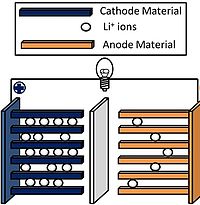
Photo from wikipedia
The influence of relative content of a metal component on the phase composition and substructure of Cox(MgF2)100 – x in a wide range of x = 16–63 at % is studied by… Click to show full abstract
The influence of relative content of a metal component on the phase composition and substructure of Cox(MgF2)100 – x in a wide range of x = 16–63 at % is studied by X-ray diffraction (XRD), X-ray photoelectron spectroscopy (XPS) and infrared (IR) spectroscopy. The layers of nanocomposite with a micron thickness have been obtained by the ion-beam sputtering of the target in the argon environment. The results reveal that the relative metal cobalt content in the MgF2 dielectric matrix strongly affects the phase composition and substructure of nanocomposites. With a lower content of cobalt, it is in the amorphous state in the form of clusters in the MgF2 nanocrystalline matrix. An increase of cobalt content to x = 29 at % on a sitall substrate and to x = 42 at % on a glass substrate in the X-ray amorphous MgF2 dielectric matrix leads to the formation of cobalt nanocrystals with a hexagonal crystallographic system, whose sizes are on the order of 10 nm. These are predominately oriented in the basis plane of the (001) hexagonal lattice of α-Со. A further increase of cobalt content to c = 59 at % enlarges the α-Со nanocrystals to ~20 nm with retaining the same orientation. In accordance with a fine structure analysis of XPS spectra of Со 2p and О 1s, cobalt is strongly oxidized on the surface of all the composites; only on the surface of samples with a low content of Co is X‑ray amorphous cobalt found in a metallic state along with cobalt oxide. The IR spectra of these samples with the lowest metal phase content exhibit the pronounced modes from the nanocrystalline MgF2 dielectric phase.
Journal Title: Physics of the Solid State
Year Published: 2019
Link to full text (if available)
Share on Social Media: Sign Up to like & get
recommendations!